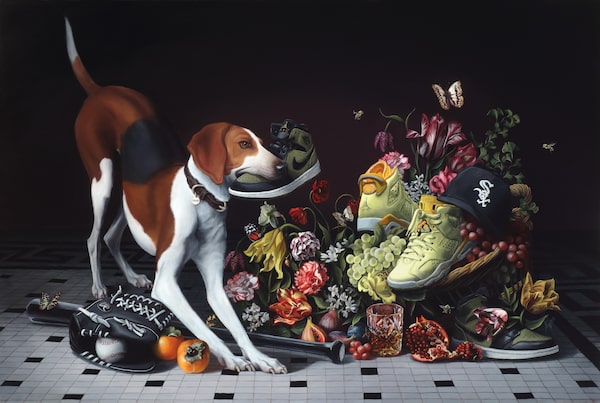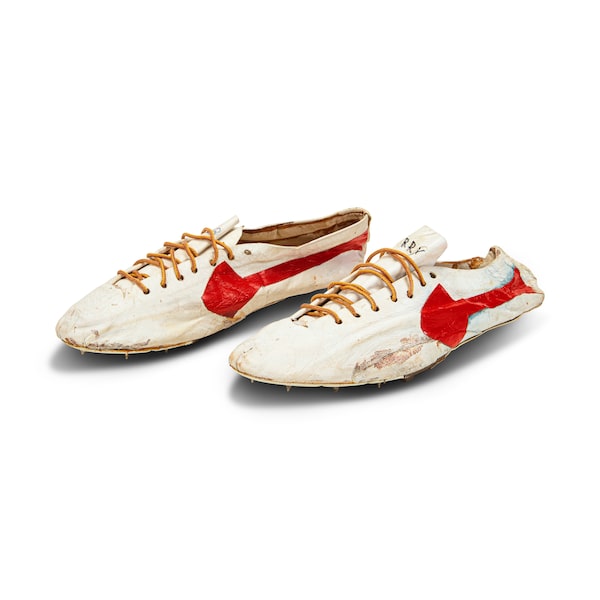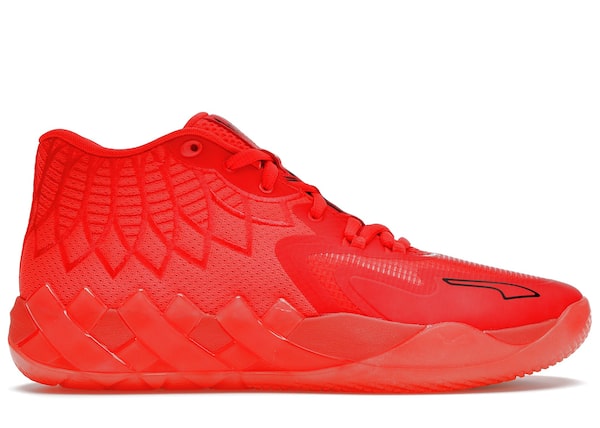
The Hunt, by Kathy Ager. For more about artist Kathy Ager, visit tgam.ca/artistKathy Ager/Supplied
Ask anyone who’s into sneaker culture, and they’ll all agree on where it was born: New York.
It started in the 1970s, when NBA scouts were turning their attention to street basketball players, and street style was coming into focus as a result. Breakdancing and hip-hop were budding forms of art. It was a moment undoubtedly driven by Black culture in America.
“All of this intertwining of basketball, hip-hop and sneakers really started in the 1970s, and it’s also there that Black culture is infusing sneakers with a desirable sense of cool that starts to get capitalized on,” says Elizabeth Semmelhack, director and senior curator of the Bata Shoe Museum in Toronto.
Meet Canada’s star sneaker resellers
Today, sneaker reselling has become a US$6-billion industry globally, according to the financial services and investment bank Cowen. The most sought after limited-edition shoes command six-figure price tags in the reselling market and can be found on auction alongside designer goods at Sotheby’s, the New York-based auction house better known for dealing fine art and jewellery. The largest shoe brands like Adidas and Nike collaborate with major celebrities like Drake and Pharrell Williams in the quest to make the next iconic shoe.

Run DMC performing at Madison Square Garden in New York City in October, 1995.David Corio/Getty Images
These are not your everyday sneakers. They aren’t even always sleek. They’ll sometimes feature a mishmash of dizzying colours, unfamiliar bulbous edges and odd patterns, like the cow print on one Ben & Jerry’s collaboration with Nike.
Years ago, you might have noticed people camped out outside the Foot Locker on Toronto’s Yonge Street for a chance to buy a limited release of a new shoe and resell it online. Today, that system has largely ended in favour of online raffles, in which you sign up for the chance to purchase one of a few hundred special edition shoes. Some might actually wear them, but many will resell those shoes online and make thousands of dollars in profit.
Dozens of reselling websites attract hundreds of millions of online visitors vying to pay thousands of dollars for limited edition sneakers that originally sold for less than $200. Shoe brands try to make the initial release of shoes fair by setting up the randomized raffles, but the industry is so lucrative that people are constantly developing complicated bots to maximize their chances of getting their hands on these shoes. Others try to flood the market with fake look-alikes.
But before the frenzy and the absurd price tags, the search for a unique pair started when basketball players first made collaborations with sneaker brands in the 1970s.
Let’s go back to the beginning in the 70s

Michael Jordan on Jan. 3, 1991.David Scarbrough/The Associated Press
You might immediately assume that Michael Jordan started it all with his iconic Air Jordans. It’s not entirely wrong – the brand was the beginning of sneaker culture’s ascent to the stratosphere. But Semmelhack also points to a lesser known player, Walt Frazier of the New York Knicks, who collaborated with Puma to make a shoe that came in buttery suede and rich colours.
“It was advertised right from the get go as something you could wear to play basketball or as a form of fashion,” says Semmelhack, who adds that Frazier was known as a well-dressed celebrity and helped bring fashion and sportswear together.
By the 80s, the culture behind sneakers started to further commercialize worldwide. Nike signed with Michael Jordan in 1985, and Adidas signed with the hip-hop group Run-DMC in the same decade, cementing music’s relationship with basketball footwear.
It was around this time that the concept of exclusivity in sneakers came to be. Young people wanted to find ways to stand out, so they started to look for “dead stock,” Semmelhack says. That means they went to shoe stores searching for older, more obscure sneakers in warehouses and backrooms that might have never sold in an attempt to find something no one else was wearing.
Shops began to offer rare and in-demand sneakers by the 90s, and the advent of the internet meant entrepreneurial individuals were beginning to make a business out of reselling shoes.
For the next decade or so, buying sneakers online was a tricky process. You had to rely on your own instincts or help from small forums to figure out if the pair on eBay was real or fake.
As the internet matured into the 2010s, sneaker culture only expanded
Simon Wood, a well-known figure in the sneakerhead community who started one of the world’s first magazines around the culture, says 2010 is when sneaker e-commerce really started to take off, and it all had to do with the launch of Instagram and social media’s emphasis on images.
“Instagram in particular started to change the communication dynamics away from blogs and toward people taking photos of their shoes and styling them. Now it wasn’t just the media outlets showing shoes, it became more of a community,” says Wood, a lifelong sneaker collector who lives in Melbourne, has written books on the culture and continues to run a website called Sneaker Freaker. He was too embarrassed to say how many pairs of sneakers he owns.
“Prior to that … the hardcore aficionado nerds were on text forums, but as soon as Facebook and Instagram got rolling, it went to a wider audience.”
Still, there weren’t many options for buying limited-run sneakers. You could try your luck on eBay auctions or you could travel to legendary brick-and-mortar shoes stores like Flight Club in New York and Los Angeles.
With the tech boom, sneakers started trading like stocks
When venture capital money started flowing to dedicated reselling platforms in the mid-2010s, there was a belief big money could be made by facilitating the sale of rare shoes.
One of those companies is Detroit-based StockX. Since its launch in 2016, StockX has become one of the biggest reselling websites in the world with more that 37 million trades facilitated and hundreds of millions of site visits per year. Greg Schwartz, chief operating officer and co-founder of the company, says StockX’s goal is to bring a sense of confidence into the reselling market. Many people involved in sneakers look at their purchase as an investment, and Schwartz wanted people to be able to trust what they were buying.
“We started with this belief that we could look at how the world’s financial exchanges operate … they remove a lot of friction and drive liquidity and there’s inherent trust in what you’re buying from the New York Stock Exchange or the Nasdaq,” says Schwartz.
“Those same core tenets were lacking when you looked at the consumer marketplace, you had no trust.”
StockX sought to build that trust through a robust team of 300 experts at authentication centres around the world (including one in the Toronto area) who verify that each item is real. The company authenticates 1 million products monthly (they also sell non-sneaker items like sports memorabilia and other forms of streetwear), and in 2022 alone they’ve rejected nearly 300,000 products, which equates to US$80-million dollars worth of goods.
Some of the rejections are for clerical errors like wrong sizes, but many are fake products, too.
It would be painful to spend $1,000 on a pair of sneakers only to realize they’re not authentic when you put them on. But Schwartz is also thinking about the people who’ll never even wear the shoes – he’s thinking about the consumers that are using sneakers as a form of investment.
Currently, he says his platform could be comparable to Ticketmaster, which verifies the reselling of sought-after concert tickets. But with the skyrocketing dollar value of sneakers, his vision for the future of the company is to take it from being like Ticketmaster to something like his original inspiration, a stock exchange.
“We’ve always believed that there’s future where people can buy and sell without even taking possession,” says Schwartz, who points out that people don’t buy shares in a gold company to hold a piece of gold. They just want the value and the ability to day-trade to maximize their profits.
It all may seem a bit soulless compared to the beginnings of sneaker culture when kids roamed stores to find deadstock that nobody was wearing.
But Wood points out that making a popular, sought-after shoe isn’t necessarily an easy thing. It’s not like every shoe a major brand produces, even with celebrity collaboration, shoots up in value from $200 to $50,000 a pair. And it isn’t always easy for resellers to figure out what shoe will be a hit.
“Nike and other big brands can do whatever they want, but it’s up to us as consumers and fans whether we actually embrace it or not,” says Wood.
What do the sneaker brands win out of all this hype?
At one point, shoe brands were releasing 20 special edition shoes per week and jockeying with each other for popularity. Brands have ascended and descended over time because of the artists they partner with, such as New Balance, which moved past its reputation as a boring shoe company over the past decade.
A fair question at this point would be: What’s in it for the shoe brands themselves?
On one hand, Wood says you could argue there’s no benefit. After all, Nike or Adidas will sell their sneakers for around $200, only for resellers to make obscene profits.
But Semmelhack says there are two ways that shoe companies benefit from this system. The first is that the frenzy created from limited quantities of shoes is a fantastic form of marketing.
“Companies might only be selling these for 200 bucks a pop or whatever it is … but it’s doing a lot of advertising work for that company that initiated the shoe,” says Semmelhack.
“It’s keeping sneakers at the tip of everyone’s tongue.”
The other benefit is that shoe brands can take part in the cultural fervour without being lambasted for selling their shoes at inflated prices themselves. Semmelhack says in the current market, outrage is deflected away from the brands and toward the resellers themselves.
Resellers: A necessary evil?
And make no mistake, there is criticism around shoe resellers. Wood says resellers are a vital part of the ecosystem, but the relationship between sneaker community and resellers has always been a complicated one.
“Resellers are the hyenas of the world, the scavengers,” says Wood. “But they’re a necessary evil.”
Much of the anger toward resellers comes from the proliferation of bots, which can automatically put high numbers of entries into shoe raffles to maximize a reseller’s chances of getting a pair of sneakers before it sells out.
But in Wood’s opinion, bots are just an easy target. The reality is that bots are incredibly complicated to operate, and they can be very expensive to purchase in the first place. Moreover, brands have upped their efforts to detect bots and ban those that use them.
“They are a scourge … but I don’t think they’re as widespread as they used to be,” says Wood.
Like any subculture that involves expensive, sought-after goods, there’s always been trouble. In the days of overnight lineups at shoe stores, Wood says there’d be thug-types who would break up the line to get into stores first. In 2005, Compton rapper The Game even rapped about a friend getting killed for his shoes in the song Hate It or Love It, and warned against anyone trying to mess with him for the same reason.
There will always be people lamenting about the good old days, Wood says. But it’s clear that sneaker reselling and the shoes’ place in modern pop culture will continue to morph. After all, imagine telling someone in the 80s that a pair of basketball shoes could be sold by a fine art auctioneer like Sotheby’s for more than a million dollars.
Notable sales

Michael Jordan's earliest known regular season Nikes.Supplied
US$1,472,000: Michael Jordan’s earliest known regular season Nikes: Game worn and signed Air Ships

Bill Bowerman handmade prototype.Supplied
US$315,000: Nike co-founder Bill Bowerman’s handmade prototype logo track spikes with waffle sole

The Louis Vuitton and Nike Air Force 1 & Pilot Case.Supplied
US$1,687,600: Nike x Louis Vuitton Air Force 1 & Pilot Case (total price for eight pairs, sold separately) which each ranked in Sotheby’s top 10 most expensive shoes sold at auction
Source: Sotheby’s
Notable brands
While Nike is coveted amongst sneakerheads, here are brands gaining popularity on the resale market.
Hoka

Hoka One One Anacapa.Supplied
Sales growth: 3,606 per cent
Partnerships with brands such as Moncler have spurred a must-have reputation.
Puma

Puma MB.01.Supplied
Sales growth: 415 per cent
LaMelo Ball’s MB.01 is fuelling this brand’s growth and popularity.
New Balance

New Balance 550.Supplied
Sales growth: 200 per cent
“Dad styles” like the New Balance 550, which is worn by supermodels too, have spiked interest.
Source: StockX